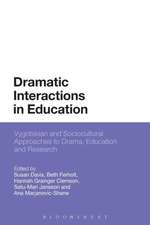Creativity and Making in Early Childhood: Challenging Practitioner Perspectives
Autor Dr Mona Sakr, Roberto Federici, Nichola Hall, Bindu Trivedy, Laura O'Brienen Limba Engleză Paperback – 8 aug 2018
| Toate formatele și edițiile | Preț | Express |
|---|---|---|
| Paperback (1) | 184.59 lei 3-5 săpt. | |
| Bloomsbury Publishing – 8 aug 2018 | 184.59 lei 3-5 săpt. | |
| Hardback (1) | 568.14 lei 6-8 săpt. | |
| Bloomsbury Publishing – 8 aug 2018 | 568.14 lei 6-8 săpt. |
Preț: 184.59 lei
Preț vechi: 214.78 lei
-14% Nou
Puncte Express: 277
Preț estimativ în valută:
35.33€ • 38.36$ • 29.67£
35.33€ • 38.36$ • 29.67£
Carte disponibilă
Livrare economică 02-16 aprilie
Preluare comenzi: 021 569.72.76
Specificații
ISBN-13: 9781350003095
ISBN-10: 1350003093
Pagini: 200
Ilustrații: 30 bw illus
Dimensiuni: 156 x 234 x 15 mm
Greutate: 0.32 kg
Editura: Bloomsbury Publishing
Colecția Bloomsbury Academic
Locul publicării:London, United Kingdom
ISBN-10: 1350003093
Pagini: 200
Ilustrații: 30 bw illus
Dimensiuni: 156 x 234 x 15 mm
Greutate: 0.32 kg
Editura: Bloomsbury Publishing
Colecția Bloomsbury Academic
Locul publicării:London, United Kingdom
Caracteristici
Through 'theory boxes' readers will engage with theoretical perspectives on creativity ranging from concepts taken come from education, psychology, sociology, semiotics and cultural studies
Notă biografică
Mona Sakr is Lecturer in Education and Early Childhood at Middlesex University, UK. She is author of Digital Technologies in Early Childhood Art (Bloomsbury, 2016). Roberto Federici is an Early Years Practitioner at Mount Carmel Kindergarten, Hertfordshire, UK. Nichola Hall is an Early Years Practitioner at Merchant Taylors' Prep Nursery, Hertfordshire, UK. Bindu Trivedy is an Early Years Practitioner at Rowland Hill Children's Centre and Nursery, London, UK. Laura O'Brien is an Early Years Practitioner at St Albert The Great RC Primary School, Hertfordshire, UK.
Cuprins
Introduction Part I: What is Creativity? 1. Looking for Creativity 2. Creativity and Identity 3. Collaborative Creativity Part II: What Are the Conditions for Creativity? 4. Time 5. Choice 6. Space and Materials7. Digital Creativity Part III: How Can Practitioners Support Children to Be Creative? 8. Child-Adult Interactions 9. Inspirations for Creative Activities 10. Adult Expectations Conclusion References Index
Recenzii
This energetic and engaging text offers practitioners new ways forward. Informed by research which is shared in an accessible manner, it is packed with rich examples of children playfully making and creating. It will not only prompt reflection and deeper understanding of children's creative identities, it will also help shape future practice. An inspiring read.
A rich resource for current and future early childhood practitioners interested in the physicality and materiality of children's creativity. Written by a team of practitioners and researchers, the book combines theory with practical suggestions, making it an invaluable guide to children's creativity.
This essential guide to early childhood creativity covers a wide range of topics that educators will find immediately relevant to their work with young children. The authors provide clear explanations of the current research and theory on young children's creativity, illustrated with practitioner observations. The reflection activities throughout the book will get educators thinking about how to provide students more opportunities for creativity, for example by examining their beliefs about time, questioning their perceptions of children's artwork, and reconsidering the physical environment they provide in the classroom.
A rich resource for current and future early childhood practitioners interested in the physicality and materiality of children's creativity. Written by a team of practitioners and researchers, the book combines theory with practical suggestions, making it an invaluable guide to children's creativity.
This essential guide to early childhood creativity covers a wide range of topics that educators will find immediately relevant to their work with young children. The authors provide clear explanations of the current research and theory on young children's creativity, illustrated with practitioner observations. The reflection activities throughout the book will get educators thinking about how to provide students more opportunities for creativity, for example by examining their beliefs about time, questioning their perceptions of children's artwork, and reconsidering the physical environment they provide in the classroom.

















